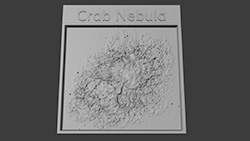1
X-ray & Infrared Images of Crab NebulaCredit: X-ray: NASA/CXC/SAO; Infrared: NASA/STScI; Image Processing: NASA/CXC/SAO/J. Major
The Crab Nebula, the result of a bright supernova explosion seen by Chinese and other astronomers in the year 1054, is 6,500 light-years from Earth. At its center is a neutron star, a super-dense star produced by the supernova. As it rotates at about 30 times per second, its beam of radiation passes over the Earth every orbit, like a cosmic lighthouse. As the young pulsar slows down, large amounts of energy are injected into its surroundings. In particular, a high-speed wind of matter and anti-matter particles plows into the surrounding nebula, creating a shock wave that forms the expanding ring seen in the movie. Jets from the poles of the pulsar spew X-ray emitting matter and antimatter particles in a direction perpendicular to the ring. These images show the X-ray data from Chandra along with infrared data from the Webb space telescope.
2
Cassiopeia A Still Images (X-ray & Optical):Credit: X-ray: NASA/CXC/SAO; Optical: NASA/STScI; Image Processing: NASA/CXC/SAO/J. Major, A. Jubett, K. Arcand
Cassiopeia A (Cas A for short) is the remains of a supernova that is estimated to have exploded about 340 years ago in Earth’s sky. While other Chandra movies of Cas A have previously been released, including one with data extending from 2000 to 2013, this new movie is substantially longer featuring data from 2000 through to 2019.
The outer region of Cas A shows the expanding blast wave of the explosion. The blast wave is composed of shock waves, similar to the sonic booms generated by a supersonic aircraft. These expanding shock waves are sites where particles are being accelerated to energies that are higher than the most powerful accelerator on Earth, the Large Hadron Collider. As the blast wave travels outwards it encounters surrounding material and slows down, generating a second shock wave that travels backwards relative to the blast wave, analogous to a traffic jam travelling backwards from the scene of an accident on a highway.
The outer region of Cas A shows the expanding blast wave of the explosion. The blast wave is composed of shock waves, similar to the sonic booms generated by a supersonic aircraft. These expanding shock waves are sites where particles are being accelerated to energies that are higher than the most powerful accelerator on Earth, the Large Hadron Collider. As the blast wave travels outwards it encounters surrounding material and slows down, generating a second shock wave that travels backwards relative to the blast wave, analogous to a traffic jam travelling backwards from the scene of an accident on a highway.
3
Crab Nebula Still Images (X-ray):Credit: X-ray: NASA/CXC/SAO; Image processing: NASA/CXC/SAO/J. Schmidt, J. Major, A. Jubett, K. Arcand
The Crab Nebula, the result of a bright supernova explosion seen by Chinese and other astronomers in the year 1054, is 6,500 light-years from Earth. At its center is a neutron star, a super-dense star produced by the supernova. As it rotates at about 30 times per second, its beam of radiation passes over the Earth every orbit, like a cosmic lighthouse. As the young pulsar slows down, large amounts of energy are injected into its surroundings. In particular, a high-speed wind of matter and anti-matter particles plows into the surrounding nebula, creating a shock wave that forms the expanding ring seen in the movie. Jets from the poles of the pulsar spew X-ray emitting matter and antimatter particles in a direction perpendicular to the ring. These images show the X-ray data taken over time from Chandra.
4
3D Printable Files: Cassiopeia A (3D Print Credit: NASA/CXC/A. Jubett, using software by Tactile Universe/N. Bonne & C. Krawczyk & Blender)
The tactile plate of Cassiopeia A is a physical relief map based on the intensity of X-ray and optical data, depicting this famous supernova remnant. The data show a disk of energy with marbled streaks. X-rays from Chandra reveal puffs of hot gas, mostly from supernova debris from the destroyed star, and include elements like silicon and iron. Brilliant stars shown as points protruding from the surface of the plate, in optical light from Hubble, permeate the field of view.
5
3D Printable Files: Crab Nebula (3D Print Credit: NASA/CXC/A. Jubett, using software by Tactile Universe/N. Bonne & C. Krawczyk & Blender)
The tactile plate of the Crab Nebula is a physical relief map based on the intensity of X-ray data, taking the shape of a spinning toy top, made of wispy clouds, resting on its side. The top-like shape is outlined by feathery shrouds of energy. In the center, where the point of the toy top shape meets its flared body, is a ball of concentrated light. This is the pulsar, a rapidly rotating neutron star, at the heart of the Crab Nebula. Concentric circles surround the pulsar, as if the pulsar was a small pebble that was dropped into a puddle of water. From the bottom of the neutron star, a jet of matter is rushing downward, like scalding hot steam being released from a valve.
Return to: NASA's Chandra Releases Doubleheader of Blockbuster Hits (April 24, 2024)



















































































